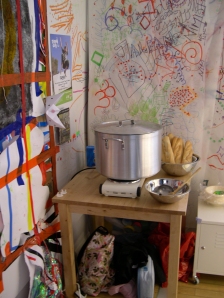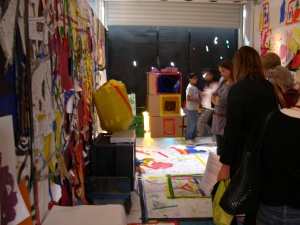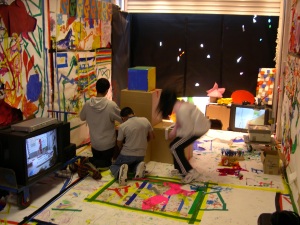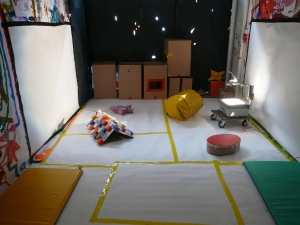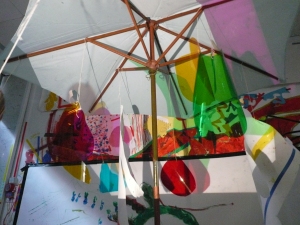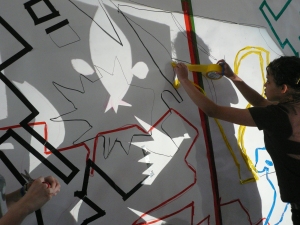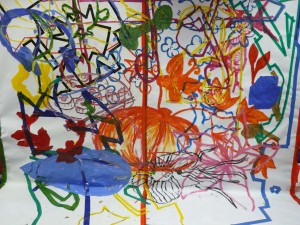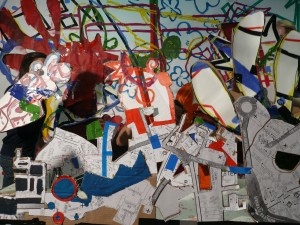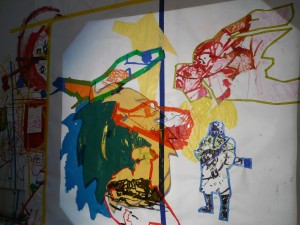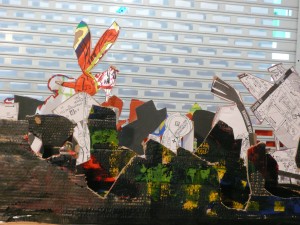it’s great. it’s fun enjoyable and the fun the part was explore line
i think this workshop was great fun and really entertaining.the best bit was drawing faces and and drawing lines while the person moves the board.
It’s great and fun, you never get bored. It’s enjoyable and my favourite was the painting and explore lines.
I enjoyed the workshops i did at the city gallery .The line one was the best i think because it was amazingyhow you could draw lines on the wall and it would look so briight .while you were playing games.On the ohp in the light workshop the pattens were nice on the wall.That we made by sticking all sorts on to OHP paper.
The celebration event on Tuesday was an opportunity for everyone to see how the educational space had evolved over the past few weeks, for each person to get a copy of the newly published newspaper and to sample some summer soup!
The boxes used in the 0-3 year old workshop were stacked against the blacked-out window – a section at the bottom of which was cut away to reveal sun light which shone through the coloured gel windows in the boxes and cast multicoloured rays across the floor of the space. Three TV screens were positioned in the space and were showing the animation films that had been put on the blog over the past few weeks. These films had recorded all the workshops that ‘Measure by Measure’ had organised and also detailed a slide show of images from the ‘Play and Explore’ workshops.
Stacks of ‘The New Curriculum’ newspaper, which documented the Dalry Primary School project and the soon-to-be-launched ‘School on Paper’ newspaper, were placed on the white cupboards, ready to be unveiled. The summer soup was gently simmering on the hotplate in the corner of the space ready for the hungry visitors.
Bryan gave a speech which outlined the ideas of the workshops and he expressed our pleasure in having had the opportunity of organising them and at the positive reaction and engagement of all the participants. He thanked everyone involved: Hugo, Lisa, and all the gallery staff with a special mention for Dave who helped us out on many occasions (some of which were emergency situations!) to locate equipment and materials.
The ‘School on Paper’ newspaper was launched and handed out to the gathered audience. Summer soup, a delicious potato, carrot and dill recipe was served by Natalia as people formed a queue to sample the home cooked fare.
People filtered into the main body of the gallery to look at the exhibits in the exhibition and into the learning space in the front gallery which was a riot of colour from all the workshop projects and a cacophony of noise greeted them as the music from the films was playing. The space was still being worked on by Priyesh, Tej, Nidhi and Alisha who were busily projecting shapes from the OHP onto a section of the wall which still had a few white areas left. They were also using sticky tape and marker pens to create some colourful shapes, images and marks on the paper. Isobel from the 7-13 workshop, and George and Dan from the 12- 17 workshop were also working in the space projecting onto the wall shapes that they had cut out from the coloured gels on to the wall.
It was great to see the workshop participants returning to the space to see the films – they had been involved in the making of the characters and backgrounds out of paper and cardboard and now they could see their endeavours and that material transformed into an animation on a monitor screen.
Towards the end Priyesh, Tej, Nidhi and Alisha started to experiment with the cardboard boxes and with the windows of coloured gels, and after putting them on their heads, they paraded around the space and then into the main gallery wearing their new costumes! Even more inventively, they started to create buildings from the boxes by stacking them up and getting inside – maybe the new building design of the future!
We looked in the pot. Nearly all the soup had gone, so not too much to take home – people must have been hungry……
We were really delighted that so many people attended the event and many thanks to all who came; it was really stimulating to talk to those who participated in the workshops, to their friends and family and to the number of people who had travelled a considerable distance to attend the occasion.
Thank you all very much – we hope you enjoyed yourselves as much as we enjoyed ourselves!
The children and adults were invited into the space to explore and play – to look at the colours, shapes and images that were all around them. They were given tape, crayons and paint to draw round objects and mark out where things were positioned. One of the ideas was for the adults to draw round the babies as they negotiated and moved round the space – moving and marking. When the OHP was switched on paint and tape was used liberally to define objects where they cast a shadow. People started drawing round the shadow that their hand made on the wall – there was a lot of paint everywhere!
Coloured gels (the shapes used were of the favourite food of the children) were cut up and placed on the OHP to create a colourful environment and another way to see the space. The children started to play by moving the shapes of the gels on the OHP.
The boxes with the windows were position around the floor space and after a little exploration, encouragement and persuasion the children started to go inside the boxes and look out of the coloured windows and see the world in a different light!
Patrick was then brought into the space in a white painted box – he was next to be painted! He sat down and paint was applied to the box, things were stuck to the box and he reacted by finding a different position (with difficultly!) so people had to work fast to finish painting their mark and shape.
Another large box had been prepared with a window cut out and the participants were given a sheet of paper with a special surface. They made some marks and shapes which were cut out and then stuck onto the interior walls of the box. A light was shined into the box to activate the phosphorescent paint which glowed a light green (like watch faces…) People were encouraged to look through the window of the box to see the glowing shapes.
At the break shapes were cut out to reveal a surprise underneath the paper that people had been walking on, crawling on, painting on and tapping on. As the shapes were removed red and blue shapes started to appear as the bottom layer had been painted before the workshop – there was the shape of Rachael who had been drawn round earlier and other less identifiable shapes!
Measure by Measure
Participants:
Clive Dawkes
Declan Luff
Hugo Worthy
Inigo Worthy
Alexandra Budding
Georgie Budding
Rachael Bywater
Harrison Bywater
Lisa Bywater
We began by trying to draw our emotions as a shape and ended up with stars and oval shapes. We then mixed up colours to represent this emotion as a colour and painted our shapes.
After looking at nets using unfolded boxes we then reconstructed them to build a form.
We then used play dough to model our chosen shapes from the beginning excercise.
The aim was to create a net of this shape using cardboard but some of the shapes they had chosen were quite complicated and we decided to create the nets in paper first and then transfer them to cardboard.
All the girls worked really hard as this was very challenging to do. But they were determined not to give up and all the participants stayed longer with their parents waiting as we all worked hard to finish. We did all create our shapes in cardboard as nets which were then painted and constructed as a sculpture in the space. There was a real sense of satisfaction and achievement for the girls as we finished – I don’t think they believed they could do it!
Some comments from participants:
‘It was challenging but good!’
‘It was different from school because it was ‘fun-ner’…We’ve made nets before at school but not big things from cardboard that you could paint afterwards.’
Workshop Leader – Penny Davis
After a brief look at the difference between ‘regular’ and ‘irregular’ shapes using the exhibition to find them we sat down to paint our own shapes and imagine them as our family and friends. They very much enjoyed this activity but found it hard to think of ‘irregular’ shapes as it did not come instinctively like thinking of squares or circles etc. So we overlapped two shapes to create an irregular shape and this became a template for shapes which we then cut out at least 14 times to create a ‘journey’ around the space. They loved the vivid colours of the neon card and this was also a new range of colour in the space.
The participants really enjoyed cutting out the shapes and watching them change slightly each time they cut out from their template and imagining what they might be. We had a ‘duck’ and a spacerocket in there – perhaps you might still find them in the space!
Then the participants each spun around a certain number of times into the space keeping their eyes closed to determine the place randomly from which they would begin their ‘journey’ with their shapes. As they almost all landed in the middle this is why our ‘map’ of ‘journey’s’ is mostly laid out on the floor. With their parents they lead the shapes towards the wall and then were directed to meet with another participant to join up the ‘journey’s’. This worked really well but we all felt that we wished we had cut more shapes or had more participants as then we could have gone crazy all over the space!
The children themselves were very pleased with what they had created and were very enthusiastic to say how much they had enjoyed the workshop.
Workshop Leader: Penny Davis
There were six participants for the adult workshop on Saturday 16th August.
In preparation for the workshop the space was darkened and two large sheets of white paper were put up on the wall.
Each person deconstructed a small box with the idea being that when projected the box could turn into an elevation of a building – so from the net of a small box to the side elevation of a piece of architecture or with a perceptual shift, the plan of a building.
They were encouraged to cut bits out of the box to create an interesting shape which was then put onto the OHP and projected onto the wall covered in paper.
Responding to the shadows they used marker pens to draw round the areas they found interesting – some selecting the whole shape and others just part of the cast shadows.
As each person finished plotting their shape the next person placed their flattened box on the OHP. People then selected coloured tape to go over the lines of the shape drawn on the wall.
An image of interest was then thought about and traced or drawn on a sheet of acetate or some people chose to cut out the shape of an image, this was projected by the OHP onto the wall and painted.
An image to make a connection with the first image was cut out from a coloured gel, put onto the OHP and projected onto the paper – projecting the image over the outlines of other peoples’ shapes was encouraged. The idea of collaboration and not being precious about the marks that had been made was one of the important ideas. The gel was kept on the OHP and the person painted over the shape on the wall having selected a colour that would change when the gel was taken away. The gel was moved a bit at a time to create an animation with the digital camera. As the gel was moved the colour changed and the original paint colour was revealed.
It was interesting to see how the gel projected onto the painted shape changed the colour and how this could be used in explaining colour theory and testing out different colour combinations.
We took a break for lunch and came back to create a collaborative animation in the afternoon.
A0 sized maps had been printed of the plan of the centre of Leicester and the participants were asked to select shapes on the maps using the shapes of the roads and buildings which would be cut out to create interesting shapes.
Shapes from the maps were cut up and randomly mixed up so each person could select a different shape from the one that they had been working on. These were then stuck onto a large sheet of cardboard to create a skyline or horizon and would be the background layer for the animation. The tricky operation of cutting round the shapes stuck to the cardboard was undertaken. Some areas of the buildings were coloured in paint or tape.
For the next step of finding a character each person selected a shape from the network of shapes and patterns on the wall – there was a head of a dog, a crow’s head, an onion, a hedgehog amongst others. These shapes were cut out and then backed on cardboard to give them strength and stability. The shapes left from the images cut out were then painted with a roller in red paint – this process was animated on the stills camera.
The next process was to assemble all the elements to create the animation – so to construct the scene one cardboard length with the skyline of buildings, created from the cut up maps, was taped to the front of a long trestle table and the remaining length was fixed on the back of the table to create a sense of depth. The table with these backgrounds was positioned in front of the original wall drawing to create a sense of colour and atmosphere.
People holding their characters were then encouraged to interact in the environment of the city-scape and move around the set under the direction of Natalia who was taking photos every few seconds. This was all captured using the digital camera and would later be turned into an animation. Coloured gels on the spot-light added to the atmosphere.
We finished the workshop by asking all the participants to come to the celebration event on Tuesday 19th August and to contribute to the online blog with comments and thoughts on a very enjoyable day.
Workshop Leaders:
Measure by Measure
Participants:
Fran Caputo
Verona Moitt
Betahn Cooper
Gina Mollett
Rebecca Barker
Louisa Humphreys
Epic Workshop 8
Workshop 8 is starting with five of us. Our two participants are George (returning from the second workshop) and his friend Dan. We all talk about a topic that is of interest to us and we search on the internet to find an image that best represents it. We end up with a collection of images including a fighter aeroplane, a Star Wars trooper, a poisonous rainforest frog, Doomsday -a character from a Superman comic- and a sci-fi troop carrier ship. We print out these images and want to project them large on the wall. To do that we have a selection of choices: we could place an acetate on the image and trace around it with a pen; when this is projected on the wall you get black lines like a drawing. We could also cut out around the image and place that cut out piece of paper on the OHP. When projected this will give us the image as a shadow on a lit wall. Alternatively we could remove the cut out shape of our image and place the remaining piece of paper (the ‘frame’) on the OHP. That will give as our image lit up on a darkened wall. We use all three ways to project the images and we use tape to mark the outline of each projection. Each topic of interest is now marked on the wall, having lost something of its original easily recognisable image to a more abstract loosely taped outline. None of the shapes on the wall touch each other and at this stage they look like island-countries with their borders clearly defined in different colour tapes each a representation of an interest.
We then draw on an acetate a second image which is related in some way to our original one. This time these images are projected onto other people’s outlined shapes and they respond to the interferences. For instance the frog gets a large lepidopteron insect which is projected onto the wall. Its wings touching the fighter aeroplane and its body the Star Wars trooper. The ’owners’ of these shapes respond by painting and marking the areas where shapes and lines overlap. In doing so we also make connections and stories that include characters and shapes that touch each other. Fighter airplane shooting at a giant jumping poisonous frog-monster, Star Wars trooper with a fly face defending himself against a raging Doomsday throwing a tank and the dead body of a fatality of all this fighting is carried away on a troop carrier ship that’s caught fire. A sci-fi plot of epic dimensions is being unfolded on the wall. In reality when the projector is off all that can be seen is outlined shapes with parts of them painted in different colours and different marks and lines dissecting them.
Next we take coloured gels and cut out shapes that could make up part of our character-shape’ s environment. These are projected on the wall as well and we paint the part of them that does not touch any shape but falls on the white wall. As we paint the coloured gels’ projections the original colour changes. We observe a yellow gel and blue paint become a funny bug juice green and a red gel and yellow paint a bright orange. We ’walk’ the gel shapes off the projection and reveal a shape painted on the wall. At this point the wall hosts outlines of shapes partly painted and is partly painted itself. We leave this arrangement to that and will return to it later.
Meanwhile we have two blown up maps of Leicester city which are laid out on the floor. We follow streets and roads to create shapes and we cut these out. We also take long strips of thick brown card and paint them with different kinds of marks and shapes that could make up the environment of our character-shapes. We also get some tracing paper and draw a line along it. We look around the front gallery and find interesting shapes to trace. The boys find curvy shapes for a dune like landscape. We cut the tracing paper along the line and mark this line on the now painted brown card. This gets cut in half to create two horizons-landscapes. Shapes drawn and painted by participants of previous workshops get transferred to our landscape cut outs. The map cut out shapes also get arranged to create horizons. All of the horizons are placed on tables one behind the other creating a diorama environment for our characters.
Our characters are cut out from the paper on the wall. As they get released from the wall underneath them the marks and colours from previous workshops are revealed. We will later paint these exposed areas red. We are all ready behind layers of horizon landscapes made of map bits and dunes created from old lines in a sci-fi city with characters moving in their final fight. The epic plot coming to a close the frog is after the lepidopteron but Doomsday rules all in the end.
N
